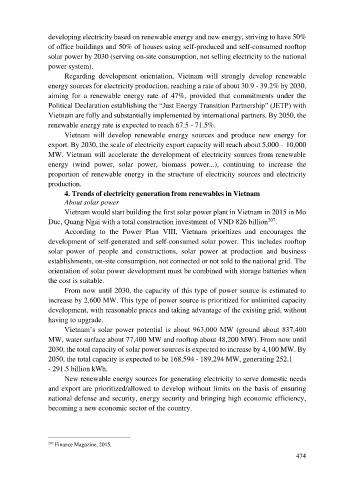Page 482 - Ebook HTKH 2024
P. 482
developing electricity based on renewable energy and new energy, striving to have 50%
of office buildings and 50% of houses using self-produced and self-consumed rooftop
solar power by 2030 (serving on-site consumption, not selling electricity to the national
power system).
Regarding development orientation, Vietnam will strongly develop renewable
energy sources for electricity production, reaching a rate of about 30.9 - 39.2% by 2030,
aiming for a renewable energy rate of 47%, provided that commitments under the
Political Declaration establishing the “Just Energy Transition Partnership” (JETP) with
Vietnam are fully and substantially implemented by international partners. By 2050, the
renewable energy rate is expected to reach 67.5 - 71.5%.
Vietnam will develop renewable energy sources and produce new energy for
export. By 2030, the scale of electricity export capacity will reach about 5,000 - 10,000
MW. Vietnam will accelerate the development of electricity sources from renewable
energy (wind power, solar power, biomass power...), continuing to increase the
proportion of renewable energy in the structure of electricity sources and electricity
production.
4. Trends of electricity generation from renewables in Vietnam
About solar power
Vietnam would start building the first solar power plant in Vietnam in 2015 in Mo
Duc, Quang Ngai with a total construction investment of VND 826 billion 207 .
According to the Power Plan VIII, Vietnam prioritizes and encourages the
development of self-generated and self-consumed solar power. This includes rooftop
solar power of people and constructions, solar power at production and business
establishments, on-site consumption, not connected or not sold to the national grid. The
orientation of solar power development must be combined with storage batteries when
the cost is suitable.
From now until 2030, the capacity of this type of power source is estimated to
increase by 2,600 MW. This type of power source is prioritized for unlimited capacity
development, with reasonable prices and taking advantage of the existing grid, without
having to upgrade.
Vietnam’s solar power potential is about 963,000 MW (ground about 837,400
MW, water surface about 77,400 MW and rooftop about 48,200 MW). From now until
2030, the total capacity of solar power sources is expected to increase by 4,100 MW. By
2050, the total capacity is expected to be 168,594 - 189,294 MW, generating 252.1
- 291.5 billion kWh.
New renewable energy sources for generating electricity to serve domestic needs
and export are prioritized/allowed to develop without limits on the basis of ensuring
national defense and security, energy security and bringing high economic efficiency,
becoming a new economic sector of the country.
207 Finance Magazine, 2015.
474

